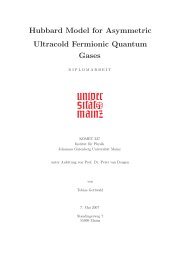5 Hirsch-Fye quantum Monte Carlo method for ... - komet 337
5 Hirsch-Fye quantum Monte Carlo method for ... - komet 337
5 Hirsch-Fye quantum Monte Carlo method for ... - komet 337
Create successful ePaper yourself
Turn your PDF publications into a flip-book with our unique Google optimized e-Paper software.
5.32 Nils Blümer<br />
For a constant default model (within some finite frequency range), the entropic <strong>for</strong>m (62) clearly<br />
favors smooth spectra. This is also true <strong>for</strong> a general smooth default model. It also en<strong>for</strong>ces<br />
positivity of A and pushes the solution towards the (normalized) default model in absence of<br />
data. From (59), (60), and (61), the posterior probability can be read off as<br />
P(A| ¯ G,m,α) = e αS[A,m]−1<br />
2 χ2 [ ¯ G,A] . (63)<br />
The balance between a tight match of data and a high entropy is calibrated by the Lagrange<br />
parameter α which may be chosen so that χ2 = Λ (historic MEM). Alternatively, one may use<br />
the value ofαwith the highest probabilityP(α| ¯ G,A,m) which can approximately be calculated<br />
within the <strong>method</strong> (classic MEM). Given the QMC data, a default model, a representation of<br />
the spectrum (i.e., a possibly inhomogeneous grid of ωj of frequencies <strong>for</strong> which A is going<br />
to be computed), and a starting guess <strong>for</strong> α, a simple MEM program thus both searches <strong>for</strong><br />
the spectrum {A(ωj)} with maximum probability P(A| ¯ G,m,α) <strong>for</strong> given α using, e.g., the<br />
Newton-Raphson <strong>method</strong> and, in an outer loop, searches <strong>for</strong> the best value ofα.<br />
The <strong>for</strong>mer procedure can be stabilized using a singular value decomposition (SVD) of the<br />
kernel:<br />
K = VΣU T<br />
(64)<br />
Σ = diag(σ1,...,σs)<br />
whereσ1 > ... > σs > 0.<br />
Here U, V are orthogonal matrices. Typically, most of the singular values σi are equal to zero<br />
(within machine precision). The columns of U T , restricted to σi �= 0, then span the same<br />
space as the columns ofK. Projecting all related quantities to this new most smaller space (socalled<br />
singular space) a stable search can be per<strong>for</strong>med. In practice, the width of the Newton-<br />
Raphson steps has to be restricted using a Levenberg-Marquardt-Parameter. An example <strong>for</strong> the<br />
application of this <strong>method</strong> is shown in Fig. 14.<br />
Alternatively to this deterministic approach, one may also use Markov chain <strong>Monte</strong> <strong>Carlo</strong> updates<br />
directly in the image space (i.e. on the level of the spectrum) with simulated annealing,<br />
as implemented, e.g., by Sandvik. This stochastic approach is however, quite sensitive to the<br />
choice of the frequency discretization, requires smoothing runs, and is computationally more<br />
costly.













